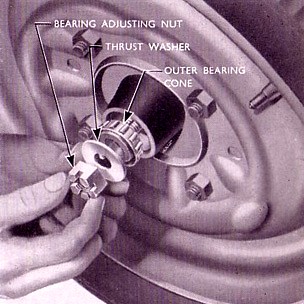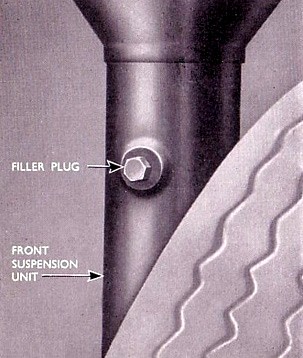The front suspension is of the independent type, consisting essentially of two coil spring suspension units incorporating hydraulic double acting shock absorbers. Two track control arms govern the limits of the front wheel track and are pivoted on the front suspension cross tube.

The stabiliser bar is secured at the forward end to rubber-mounted suspension feet and is located at the rear ends in rubber bushes in the track control arms. Fore and aft movement of the front wheels is controlled by the stabiliser, which also serves to check body roll on corners.
Normally, the only attention required is periodical lubrication, any adjustments which may be required should be made by an Authorised Ford Dealer.
Steering Gear (Anglia)
The steering gear fitted to your Anglia is of the worm and nut type. The steering worm is supported on ball bearings at each end of the worm, and shims are provided which may be removed to take up any end float.
As the above adjustments affect the steering control of the car, it is suggested that you allow your Authorised Ford Dealer to make any adjustments that may be necessary.
Check the Steering Box Oil Level (Anglia)
With the car standing on level ground, remove the rubber plug on top of the steering box. Check the oil level, which should be level with the filler plug hole. If required top up with Extreme Pressure Gear Oiluntil the level reaches the filler plug hole.Replace the rubber plug. The Steering Gear is of the worm and nut and apart from the periodic lubrication described above, requires adjustment and attention only at fairly long intervals.
Steering Gear (Prefect)
The steering gear fitted to your Prefect is of the worm and peg type. The steering worm is supported on ball bearings at each end of the worm, and shims are provided which may be removed to take up any end float. With the worm and peg type gear, an adjusting screw is also located in the top cover of the steering gear housing to eliminate rocker shaft end float.As the above adjustments affect the steering control of the car, it is suggested that you allow your Authorised Ford Dealer to make any adjustments that may be necessary.
Check the Steering Gear Oil Level (Prefect)
With the car standing on level ground, remove the filler plug in the top of the steering gear housing. Check the oil level, which should be level with the filler plug hole. If required top up with the correct Grade of Oiluntil the level reaches the filler plug hole.Replace the filler plug and tighten securely. The Steering Gear is of the worm and peg type and apart from the periodic lubrication described above, requires adjustment and attention at fairly long intervals.
Testing Wheel Bearings
Occasionally the front wheels should be jacked up and tested for free rotation and excessive bearing “play”. To determine if there is any excessive end play, grasp the wheel at the top and bottom of the tyre and rock the wheel backwards and forwards.It is important that play in the wheel bearings is differentiated from possible looseness which may exist in the various steering connections. If it has been determined that excessive play exists in the front wheel bearings, they should be adjusted.
Adjusting Front Wheel Bearings
Jack up the car and remove the hub cap (described in the section General Maintenance – Wheels and Tyres), Remove the dust cap by carefully levering it from the end of the hub.Withdraw the spilt pin, unscrew the bearing adjusting nut; remove the thrust washer and the taper roller bearing. Lift off the drum and wheel assembly.
Clean all the old grease from these components and repack with good quality wheel bearing grease. The grease should be worked carefully into the rollers and cages of the inner and outer bearings. The hub itself should not be packed completely full but an appreciable air space should be left.
Replace the hub and bearing on the spindle followed by the flat washer and castellated nut.
Tighten the bearing adjusting nut to 30lb ft (4.1 kg m) whilst rotating the wheel, and then slacken off the nut back not less than two castellations and not more than two and a half castellations.If you do not own a torque wrench, rotate the wheel whilst tightening up the bearing adjusting nut until a heavy drag can be felt, then turn the nut back one castellation at a time until the wheel is perfectly free from just perceptible end float. This is best tested at the periphery of the wheel.
Fit a new split pin; two holes are drilled in the wheel spindle to allow adjustment to one-twelfth of a turn. Carefully clean and replace the dust hub cap, and then lower the vehicle to the ground, check the wheel nuts and replace the hub cap.
Never run the car with the dust caps missing since this would allow an easy entry for grit and other road dirt
Front Wheel Alignment
If at any time it is felt that the front wheel alignment requires attention, as could be seen by some condition such as undue tyre wear or heavy steering, an Authorised Ford Dealer or specialist Tyre Supplier should be permitted to check the system with the special equipment developed for this purpose.
Top Up Front Suspension Units
The car should be parked, unladen standing on level ground.
NOTE – This is most important
Remove the combined filler and level plug located in the body of the suspension unit, approximately 3 in below the coil spring lower seat, at the front or rear of the unit, and add shock absorber fluid, Part No M-100502-E, until it reaches the bottom of the plug hole.
Replace the plug and tighten securely.
NOTE – On no account should the fluid be added to the suspension units under pressure.
Information taken from Various Ford Anglia and Ford Prefect Instruction Books and Handbooks.
Warning – The Health and Safety bit
Please note your health may be at risk if you do not take sensible safety precautions. Never work under an unsupported vehicle, do not take shortcuts. If you feel that the task is beyond your capabilities, then employ the services of a trained professional. The Ford Anglia 105E Owners Club nor the author cannot be held responsible for any accidents or injury arising from advice given on this webpage. Safety advice can be obtained from the RoSPA. The advice and opinions given are purely those of the author and not necessarily those of the Ford Anglia 105E Owners Club.


 (
( (
( (
( (
(